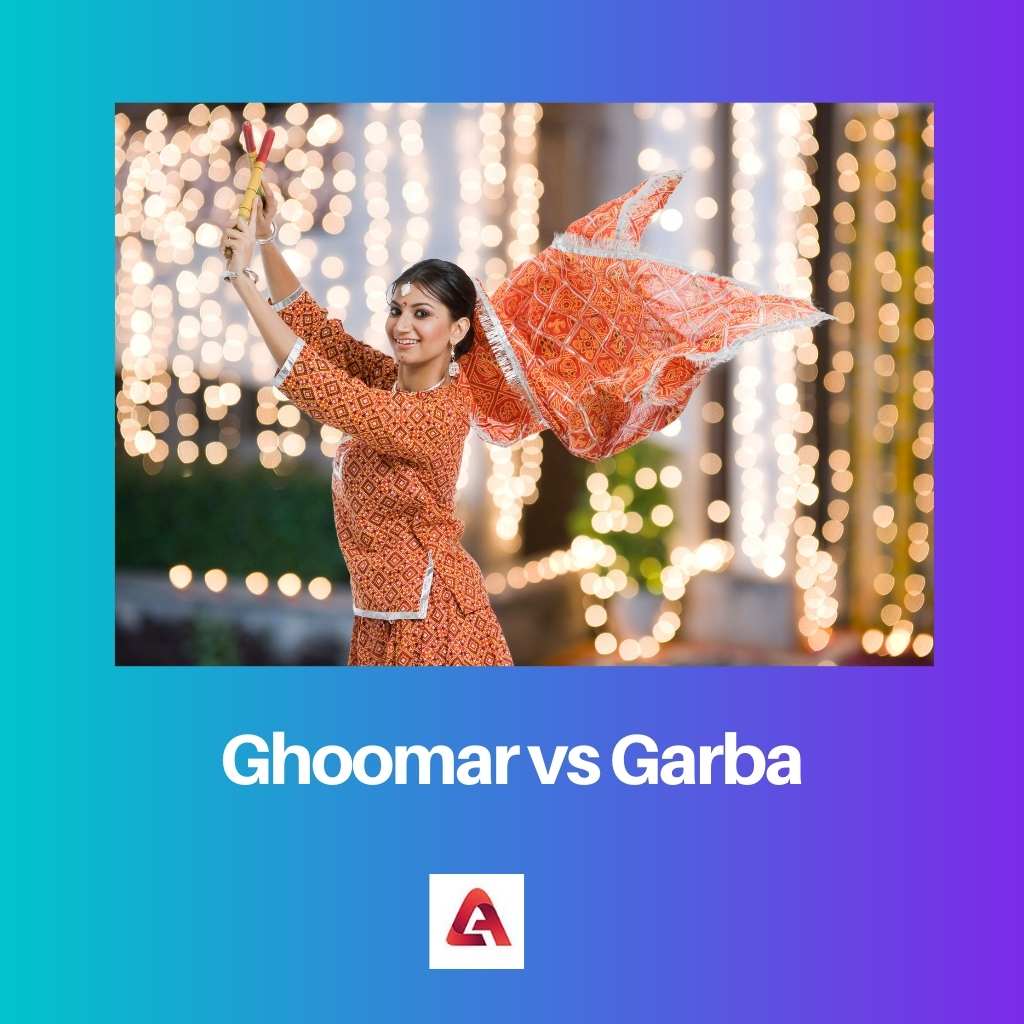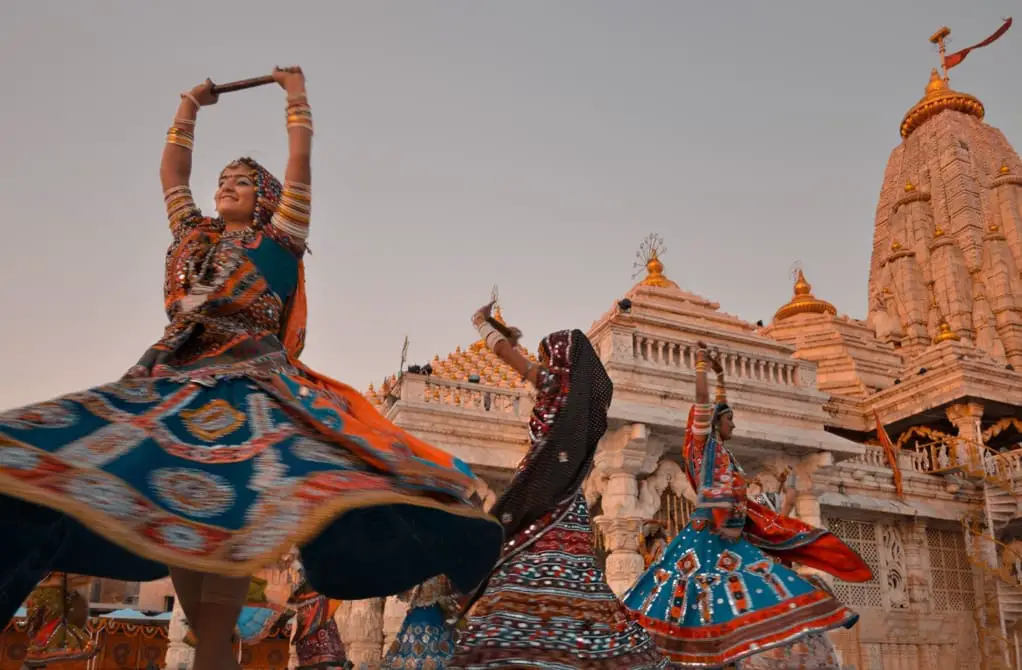Ghoomar is a Rajasthani dance that was historically produced by the Bhil tribe. Various communities in Rajasthan then adopted it, and became the state’s traditional dance.
The ballet is so smooth and beautiful to witness that it has also become a significant tourist appeal.
Garba is fundamental to Gujarati Navratri celebrations, and it is also practised at social gatherings such as festivities.
Key Takeaways
- Ghoomar is a traditional Rajasthani folk dance, while Garba is a Gujarati folk dance.
- Ghoomar features swirling movements and colorful attire, while Garba involves rhythmic clapping and circular movements around a central object.
- Both dances are performed during festivals and celebrations, with Ghoomar primarily practiced by women and Garba enjoyed by both men and women.
Ghoomar vs Garba
The difference between Ghoomar and Garba is that Ghoomar is frequently done at important events like weddings, concerts, and religious celebrations and can linger for hours. When a newlywed wife is greeted at her new conjugal house, she is supposed to perform the Ghoomar. On the other hand, Garba is a communal circular dance originating from Gujarat, a region in northwestern India. The dance style developed in Gujarati villages, where it is conducted in common meeting areas in the heart of the hamlet by the whole community.

Ghoomar is a classic Rajasthani ethnic dance. The Bhil community did it to honour Deity Sarasvati and other Rajasthani clans eventually adopted it.
The technique is mostly done by veiled ladies dressed in billowing Ghaghara gowns. Pirouetting simultaneously going in and out of a large circle is distinctive of the dance.
The term ghoomna, which depicts the whirling action of the performers, is the root of the phrase Ghoomar.
Garba is a ritual that acknowledges, worships, and embraces holiness in its feminine aspect.
Customarily, the dance is done by women in a loop surrounding a garbha profound, a ceramic lamp with a spark within.
The vessel ultimately is a representation of the soul, inside which divinity manifests itself in the embodiment of a Goddess or Deshmukh.
Garba is performed around this icon to acknowledge the concept that all mankind contains Devi’s holy essence.
Comparison Table
| Parameters of Comparison | Ghoomar | Garba |
|---|---|---|
| Nature | A realistic depiction of daily life in bygone generations that also allures present spectators. | Garba is a ritual that praises, idolizes, and adores holiness in its feminine essence. |
| Originality | It is a renowned Rajasthani typical dance. | Garba is a pattern of movement that emerged in Gujarat. |
| Meaning | It was conducted to revere High priestess Sarasvati, and it was subsequently inherited by other Rajasthani ethnicities. | Garba is indicated by the presence of a strategically positioned light or a portrait or shrine of the Goddess. |
| Costume | Ghoomar’s dress-up is Ghagra choli. | Garba dress up is Chaniya choli. |
| Invented By | Ghoomar dance was established by the Bhil community. | Gujarati regions were mainly vital for the formation of the Garba. |
What is Ghoomar?
When Ghoomar is performed as a joyous dance, the color remains part of the festivities. For millennia, various Indian and Western ladies have been captivated by the colors, motifs, and whirling scarves of Rajasthan.
Ghoomar, a folk movement form that developed in Marwar, Rajasthan’s ancient capital, popularised attire such as Chaniya Choli and Ghagra Choli.
It is a tribute to the Divine and a commemoration of girls entering womanhood.
Ghoomar is an ancient Bhil tribal cultural dance intended to honour the empress Sarasvati, which was eventually incorporated by other Rajasthani ethnicities.
They were a powerful society at the period, at odds with Rajput monarchs.
After much battling, they reached an agreement and began engaging with one another. Men were not permitted to attend these dancing recitals.
Ghoomar emerged prominently during the kingdoms of Rajput monarchs in the Indian province of Rajasthan and is primarily conducted by ladies on special ceremonies.
Women do the Ghoomar while wearing ghoonghat that hides their faces. With the varied areas of Rajasthan, the traditional dance obtains unique looks and a minor modification in a dress.
In locations bordering Gujarat, Ghoomar is done with quicker beats and steps identical to Garba.

What is Garba?
When there are a large number of participants, Garba is done in a concentric round. The circle symbolizes the Hindu concept of eternity. The clock is perennial in Hinduism.
The sole stable in the middle of all of this unceasing and limitless activity is the Goddess, a motionless emblem in the wake of the passage of time, from creation to existence to burial to reincarnation.
The dance represents God, who is depicted in feminine aspects in this example, like the one consistent in an ever-changing cosmos.
Garba, like other Hindu rites and devotion, is performed barefoot on a variety of surfaces since it is integral to religious practice.
Going barefoot is a symbol of gratitude for the land on which people stroll. The leg is the bodily portion that comes into contact with the soil, the holy mother of everything.
The ground has generative capabilities, and the foot is regarded to be the gateway via which the earth’s dynamic essence goes through humans.
Another method to interact with Devi is to dance barefoot.
Garba dances commemorate fertility, exalt women, and pay homage to a variety of mother divinities.
In Gujarat, the dances are traditionally performed to commemorate a girl’s first menstrual cycle and her impending marriage.]
Garba dance is also practised throughout the nine-day Navratri celebration, although males may join on occasion, women comprise the majority of Garba dancers.

Main Differences Between Ghoomar and Garba
- Ghoomar is a classic Rajasthani folk dance. In contrast, Garba is a type of dance that emerged in Gujarat.
- Ghoomar is a hallmark of femininity in the heart of Rajasthani culture. In contrast, Garba is a fertility celebration that honours women and pays homage to all nine incarnations of mother deities.
- Ghoomar is a genuine portrayal of daily life in previous eras, enchanting present viewers. Whereas Garba is a movement that acknowledges, venerates, and glorifies divinity in its feminine aspect.
- Ghagra-choli is a Ghoomar costume. These are edged with filigree, zari-embellished, and mirror-worked. In contrast, the typical Garba dancer attire is red, pinkish, yellow, tangerine, and brilliantly colored Chaniya choli.
- Ghoomar’s Dance is a historical Rajasthani dance produced by the Bhil caste. In contrast, Gujarati villages were traditionally responsible for the development of the Garba.
